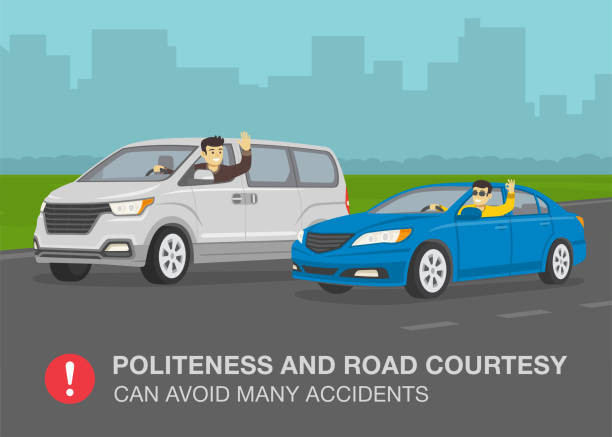Driving Etiquette: How to Be a Polite and Safe Driver
Driving etiquette is essential for creating a safe and respectful environment on the road. Polite driving not only prevents accidents but also fosters a sense of community among drivers. At Get Drivers Ed, we emphasize the importance of proper driving etiquette in our courses. Here are some tips on how to be a polite and safe driver.
Respect Other Drivers
Use Turn Signals One of the simplest ways to show respect on the road is by using your turn signals.
Signal Early: Let other drivers know your intentions well in advance to give them time to react.
Be Predictable: Consistent use of turn signals makes your actions predictable, reducing the risk of accidents.
Yield Right of Way Understanding and yielding the right of way is crucial for smooth traffic flow and safety.
At Intersections: Yield to drivers who have the right of way to prevent confusion and collisions.
To Pedestrians: Always yield to pedestrians at crosswalks and intersections.
Keep a Safe Distance
Following the 3-Second Rule Maintaining a safe following distance helps prevent rear-end collisions.
3-Second Gap: Ensure there's at least a 3-second gap between you and the car in front of you.
Increase in Bad Weather: In adverse weather conditions, increase the gap to 4 or 5 seconds.
Avoid Tailgating Tailgating is dangerous and can intimidate other drivers.
Maintain Space: Keep a comfortable distance from the vehicle ahead to give yourself ample time to react.
Be Patient: If the driver in front is moving slower, wait for a safe opportunity to pass rather than tailgating.
Practice Courtesy
Let Others Merge Merging can be stressful, especially in heavy traffic.
Be Considerate: Allow other drivers to merge into your lane safely by adjusting your speed.
Zipper Merge: Use the zipper merge technique in heavy traffic to keep traffic flowing smoothly.
Use Your Horn Sparingly The horn is a tool for safety, not for expressing frustration.
For Emergencies Only: Use the horn only to alert other drivers of immediate danger.
Avoid Aggression: Avoid using the horn out of anger or frustration, as it can escalate situations.
Follow Speed Limits
Obey Speed Limits Speed limits are set for safety reasons and should be adhered to at all times.
Drive at Safe Speeds: Follow posted speed limits and adjust your speed according to road conditions.
Slow Down in School Zones: Always slow down in school zones and residential areas where children may be present.
Adjust Speed for Conditions Driving at the appropriate speed for the conditions is crucial for safety.
In Bad Weather: Reduce your speed in rain, snow, fog, or ice to maintain control.
At Night: Drive slower at night when visibility is reduced.
Use Headlights Properly
Turn On Headlights Using your headlights correctly improves visibility for you and other drivers.
In Low Light: Turn on your headlights at dusk, dawn, or in bad weather.
When Visibility is Low: Use headlights when visibility is low to ensure you are seen by others.
Avoid High Beams High beams can blind other drivers, creating a hazardous situation.
Use Low Beams: Use low beams when other vehicles are nearby.
Turn Off High Beams: Dim your high beams when approaching or following another vehicle.
Be Patient and Calm
Avoid Road Rage Road rage is dangerous and can lead to aggressive driving behaviors.
Stay Calm: Keep your cool even when other drivers are rude or aggressive.
Don’t Engage: Avoid engaging with aggressive drivers and focus on your own driving.
Planning Ahead Planning your route in advance can reduce stress and improve driving etiquette.
Leave Early: Allow plenty of time to reach your destination to avoid rushing.
Know Your Route: Familiarize yourself with the route and traffic conditions to prevent last-minute decisions.
Communicate Effectively
Use Hand Signals If your turn signals are not working, use hand signals to communicate your intentions.
Indicate Turns: Use hand signals to indicate turns and stops.
Ensure Visibility: Make sure your hand signals are visible to other drivers.
Make Eye Contact Making eye contact with pedestrians and other drivers can help prevent misunderstandings.
Acknowledge Others: Make eye contact to acknowledge pedestrians and other drivers at intersections.
Confirm Intentions: Use eye contact to confirm your intentions and understand others’ actions.
Conclusion
Practicing good driving etiquette is essential for creating a safe and respectful driving environment. At Get Drivers Ed, our courses emphasize the importance of polite and safe driving habits. By following these tips, you can contribute to a safer road experience for everyone.
Ready to enhance your driving skills and etiquette? Enroll in our comprehensive online drivers ed program at Get Drivers Ed today. Let us provide you with the tools and support necessary for successful and courteous driving.

